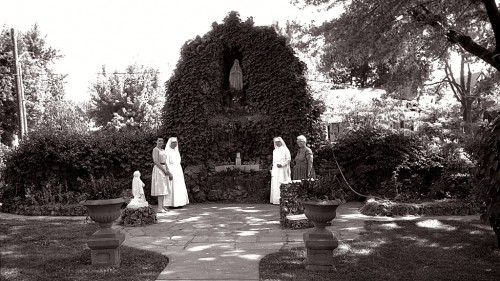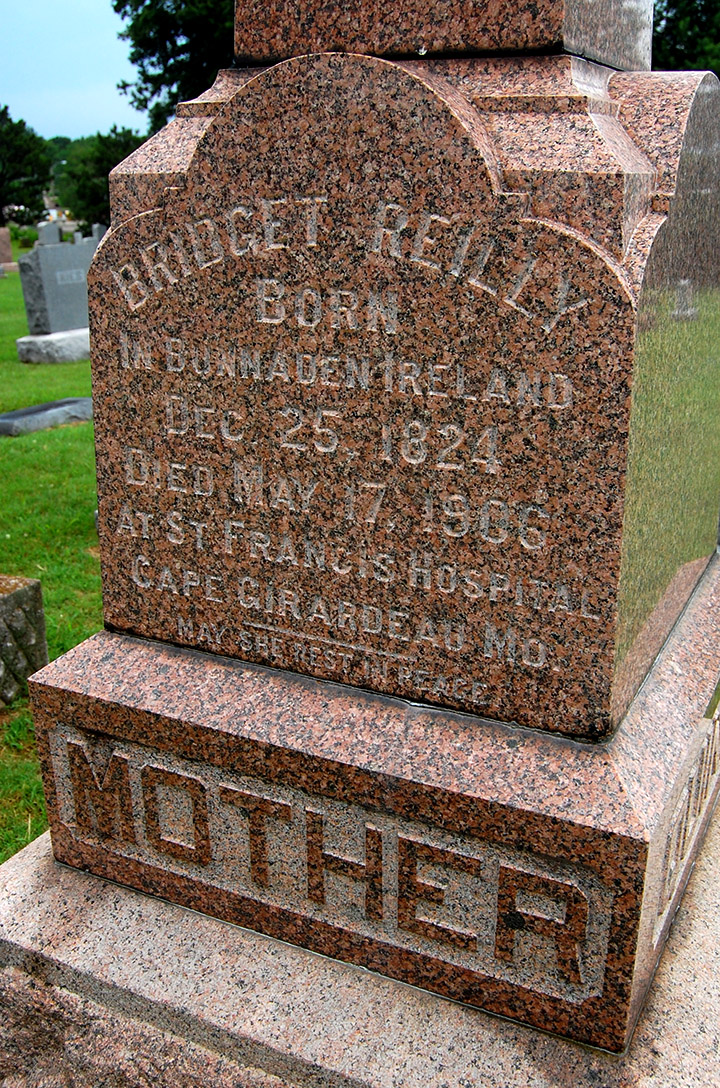This is my last in an installment of links to help out Dr. Lily Santoro’s Local Techniques in History class. The students have to research a list of local landmarks. So far, I’ve helped them with
Today we’ll look at Cape’s two major hospitals: Southeast and St. Francis.
St. Francis Hospital
 I was born in St. Francis, was treated for pneumonia there when I was a toddler, and had my tonsils yanked there. I’ve been searching like crazy for photos I took inside the place just before it was torn down, but they must have been filed someplace where I “would be sure not to lose them.”
I was born in St. Francis, was treated for pneumonia there when I was a toddler, and had my tonsils yanked there. I’ve been searching like crazy for photos I took inside the place just before it was torn down, but they must have been filed someplace where I “would be sure not to lose them.”
- St. Francis being razed
- Nun Circus and the grotto
- Patricia Foster: St. Francis Hospital Mangler
- Hospital growth 1976 – 2011
- Last baby born in old St. Francis
- St. Francis mural
- 2013 addition to hospital
- Doctors Wilson and Estes
Southeast Hospital
 The hospital on the hill overlooking Capaha Park.
The hospital on the hill overlooking Capaha Park.
- 1964 aerials of Capaha Park, Southeast Hospital and Franklin School
- Southeast Hospital at night from Capaha Park
- Homes along Broadway near Perry
- Southeast Hospital with SEMO in background
Stories I haven’t done
I hate to tell the students who have these topics that I haven’t written anything about them that I can remember.
- Post Office, 310 Frederick St.
- Wehking Alumni Center
- Cape Girardeau Municipal Court
- Missouri Park
- Crisp Hall
- Baptist Student Union

I have a Frony photo of a mock trial at City Court from 1961 in this blog:
http://www.semissourian.com/blogs/flynch/entry/36488
Cape Girardeau’s municipal courtroom was located in the sanctuary of the former Grace United Methodist Church, Independence and Sprigg streets.
The city police station moved into the former church building in 1960.
The police station had moved from the old Fire Station No. 1 at Independence and Frederick streets. That building was erected in 1909.
When the new police headquarters was built across the street, opening in 1976, the city court moved to Common Pleas Courthouse. The old church building was demolished and a new Fire Station No. 1 was constructed on the site.
There was also an Osteopathic Hospital on Spanish Street in the fifties.
When we did the hospital briefs in The Missourian, we used to joke that Southeast and St. Francis had admissions and dismissals; the Osteopathic Hospital had admissions and obits.
Ken – Assuming your reply is based on your experience as a highly respected investigative journalist? Disparaging remarks about businesses (especially those who offered care) that have now gone by the wayside should be made at least 4-5 generations out – this is so those of us who were patients or employed there have gone on to higher realms & so will not be hurt by your words.
Whether it was true or not, I heard that joke repeated in the newsroom. Did the observation ever make it into print, of course it didn’t.
I won’t apologize for passing on something I heard in a newsroom nearly 50 years ago. And, I can assure you that I heard much worse in the ERs, cop shops and fire departments I hung around in.
If you were a patient, I’m sure the hospital gave you the best care it could. If you were an employee, I am sure you were an exemplary one, and I am sure you never made a questionable remark.
I did not intend to hurt your feelings, but I also won’t withdraw the comment.
Please let me in on the joke I was born March 26, 1951 Cape Osteopathic Hospital 105 So. Spanish Street I was feeling a little nostalgia about the place where I was born! today’s date is March the 17,2016 the Doctor that delivered me was Dr. Ringland?
Hello Patricia,
I, too, was born at the Cape Osteopathic Hospital on May 18, 1951; you arrived about (7) weeks earlier. . My precious Mother said I was delivered by Dr. Newell. The hospital has always held special memories for my Mother and me.
If you are on fb, I would love to be a fb friend of yours. In the meantime, enjoy your upcoming Birthday on March 26th (2023)!!!!!
Ken, All I can say is I underwent surgery there as a child and received excellent care.
Cape Osteopathic Hospital opened at 105 S. Spanish in 1949.
Here is a Frony photo:
http://www.semissourian.com/blogs/flynch/entry/53577
But Ken, apparently the “observation” or joke, did make it into print; Ergo, your comment. And of course its not true. Every acute care facility in the State of Missouri was & is inspected yearly by the same governmental authority. It is called the Joint Commission of Hospital Standards.
You didn’t hurt my feelings. Sticks & Stones you know.
I did not expect nor ask for an apology. Apologies like empathy is no longer visited upon these days.
I merely believed that you, as a professional would consider the ethics of true journalism & that is the moral principles surrounding what you say in word or print. Especially in print.
The ethos that separates you from the tabloids.
The tenet that your words alone, are above reproach.
I considered you to have a certain distaste for the use of “gossip”. Even if the joke was passed around 50 odd years ago, the words can still hurt. And you being the master of words, would know this.
And, you are most certainly correct in your assumption that I too have made questionable remarks.
The difference Ken, is mine were never published.
I did some thinking about our exchange last night and did a little “investigative reporting” this morning to see why that comment might have been floating around the newsroom circa 1966.
Part of it perhaps reflects the feeling of that era that questioned the field of osteopathy.
“The new profession faced stiff opposition from the medical establishment at the time. The relationship of the osteopathic and medical professions was often “bitterly contentious” and involved “strong efforts” by medical organizations to discredit osteopathic medicine. Throughout the first half of the twentieth century, the policy of the American Medical Association labeled osteopathic medicine as a cult and osteopaths were seen as “cultist.” The AMA code of ethics declared it unethical for a medical physician to voluntarily associate with an osteopath.”
It wasn’t until 1969 that the American Medical Association allowed qualified osteopathic physicians to join the AMA (a measure opposed by the American Osteopathic Association, by the way). It took until 1989 before all 50 states passed laws giving those with a D.O. the same legal privilege to practice medicine as those with an M.D. degree.
Let’s look at what has happened to the three hospitals that were in existence of the time of the unfortunate joke: St. Francis and Southeast Hospitals have grown to cover acres of land and are thriving.
The Osteopathic Hospital we are discussing opened in 1949 on Spanish Street with 25 beds and a staff of 22.
In 1957, ground was broken for a new facility on Minnesota Street, just south of Jefferson School. The building project hit financial snags and the Chaffee Chamber of Commerce began working on acquiring the hospital in late 1967. The Cape building was abandoned and the land sits vacant today.
In 1969, all of the patients were transferred to Chaffee General Hospital and the Spanish street location was sold.
In 1979, The Bulletin Journal ran a story about Chaffee General Hospital celebrating its 10th anniversary. The upbeat story said the hospital had 51 beds, with about 40 of them occupied, up from the 20s and 30s when they first opened.
Information about Chaffee General Hospital was hard to find, probably because the 1991 Office of Inspector General Report on Hospital Closures had it on the list of shuttered facilities.
So, to recap the success of the Cape Osteopathic Hospital:
1. Opened in 1949 with 25 beds.
2. Planned expansion in 1957 was dead in a decade.
3. Patients were transferred to Chaffee General Hospital in 1969. It had 51 beds; and could only fill 20-40 of those.
4. By 1991, Chaffee General had closed.
In contrast, St. Francis Medical center, founded in 1914, has 282 beds and is working on a $127 million expansion and renovation project.
Planning and fundraising for Southeast Missouri Hospital started in 1923 and a 90-bed hospital was opened in 1928. SE Hospital today has 227 beds, covers blocks and has additional facilities all over Cape.
So, jests about the Osteopathic Hospital may have been in poor taste, but it appears that the perception that the facility was the loser in the hospital race in Southeast Missouri was accurate.
Did I get any facts wrong?
Your facts are probably quite correct. Do that proves what? That the Osteopathic Hospital was not well funded. So what? It’s still rude. My doctor of almost 50 years is a D.O. He’s an excellent doctor. He recently sold his practice to St. Francis Hospital. Happily the care o get from him in his office has not declined. The cost has escalated.
Let’s talk about the difference between an action and the reporting of an action.
The president of the United States mocking a Pulitzer Prize winning reporter with a physical disability is rude. Reporting the president’s actions ISN’T rude.
When I used the word “we” in the comments, I was using the editorial “we,” and merely reporting on what I had heard. Sorry that you took that to mean that I thought all D.O.s create obituary fodder.
When I spotted this tombstone in the Jackson City Cemetery, I wondered if there was a backstory to pointing out that Bridget Reilly, who was born in Ireland in 1824, died May 17, 1906 “at St. Francis Hospital.” That’s the only time I can recall the place of death being that specific. I hope I’m not rude for pointing it out.

I had my appendix removed in Cape Osteopathic Hospital in March 1955 when I was in the 8th grade at SEMS college junior/high school. The single surgical suite was on the third floor (attic). I recall the care by the physicians and nurses as of the highest quality and a real caring environment. The hospital rooms were on the second floor. Offices and nurses quarters were on the first floor. As a reminder to the author, the allopathic and osteopathic professions have merged all residency training programs under the single accreditation system (2015). All D.O. and M.D. medical school graduates now complete their training under one system with no distinction between the two. That should give you some insight on the equivalency between the medical care provided by the two professions. The past history was filled with prejudice, bias, naivety, ignorance and intolerance mainly from those without any knowledge of the real difference, if any, between the two professions.